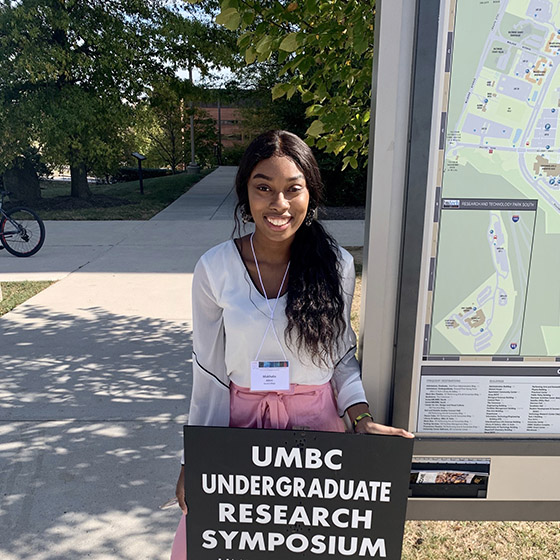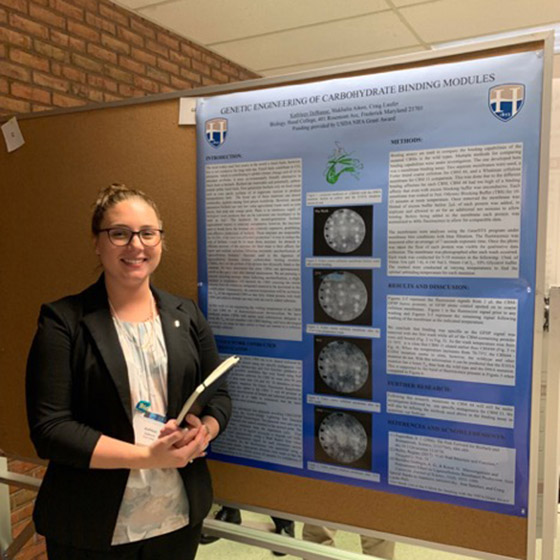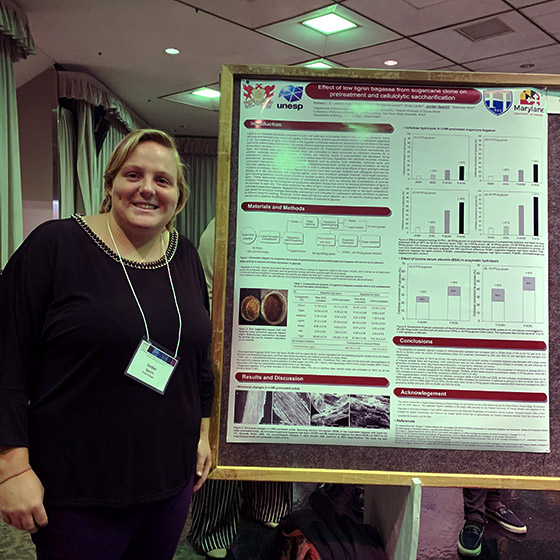Students Present Research at UMBC Symposium

Makhalia Aiken, Kathleen DeBiasse and Jordan Specht presented research at UMBC's undergraduate research symposium.
Makhalia Aiken, First-Place Award for Poster
Graduation Year
2020
Program
- Biology (B.A.)
Department
- Biology
- Chemistry & Physics
Below, Makhalia Aiken, Kathleen DeBiasse and Jordan Specht discuss the research they presented at UMBC's undergraduate research symposium:
Makhalia Aiken ’20
Biology Makhalia was awarded a first-place prize for her poster.
Makhalia was awarded a first-place prize for her poster.
My research is centered around finding a way to make biofuels a more cost-effective alternative to fossil fuels. Second generation biofuels use materials such as agricultural wastes, as feedstocks to produce transportation fuels. Although the feedstock is inexpensive, the processing, particularly the cost of the enzymes to break the biomass down into simple sugars, is expensive.
One way to notably reduce the cost of this overall process would be to reuse enzymes. This research study is to modify carbohydrate binding modules (CBMs) to facilitate their recovery for use in multiple reactions. By engineering a CBM with a melting temperature (Tm) that is below the Tm of the native enzyme, we could control the binding of the enzyme to switch on and off in order to facilitate enzyme recycling. Various mutation of CBMs were created that we predicted would lower the Tm but not interfere with the binding ability.
Kathleen DeBiasse ’20
Biochemistry
 Over summer 2019, I had the pleasure of working with Dr. (Craig) Laufer in the biology department on his biofuel research. Biofuels are an attractive alternative to fossil fuels because they are renewable and potentially carbon-neutral, meaning “eco-friendly.”
Over summer 2019, I had the pleasure of working with Dr. (Craig) Laufer in the biology department on his biofuel research. Biofuels are an attractive alternative to fossil fuels because they are renewable and potentially carbon-neutral, meaning “eco-friendly.”
However, biofuel production is expensive. Biomass used to make biofuels—such as beet pulp, orange peels or corn husks—are relatively inexpensive, but the enzymes used to break down that biomass are relatively expensive and non-reusable. So, a proposed way to reduce the cost of biofuels would be to find a way to reuse said enzymes.
An obstacle we face when trying to retrieve these enzymes is that they are “permanently” bound to a small piece of the agricultural waste even after a majority of it has been processed. When an enzyme is heated up to a certain temperature, it will unfold and become unfunctional. However, with the carbohydrate binding modules (CBMs) we are currently working with, they can spontaneously refold when brought back down to a lower temperature.
Our research is focused on genetically modifying the CBMs to lower the temperature at which they unfold because, though the CBM can refold and continue to work, its counterpart, which is also needed to breakdown the biomass, does not have the same ability. By changing the melting temperature of the CBM, we are then able to recollect the enzyme after it has completely “digested” the agricultural waste and reuse it while also keeping both pieces functional.
Jordan Specht ’22
Biochemistry
 I worked with Dr. (Sang) Kim over the summer on biofuel research, specifically looking at the effects of lignin content in sugarcane bagasse on cellulose to glucose conversion rates. Sugarcane bagasse is a by-product derived from the sugarcane stalks in the sugar industry. We looked at the differences between high and low lignin content in sugarcane bagasse, and also pretreated versus raw sugarcane bagasse. We were looking at cellulose to glucose conversion rates because the sugars can be fermented into making biofuels, which though we weren’t able to get that far, we found results on the best cellulose to glucose conversion rate.
I worked with Dr. (Sang) Kim over the summer on biofuel research, specifically looking at the effects of lignin content in sugarcane bagasse on cellulose to glucose conversion rates. Sugarcane bagasse is a by-product derived from the sugarcane stalks in the sugar industry. We looked at the differences between high and low lignin content in sugarcane bagasse, and also pretreated versus raw sugarcane bagasse. We were looking at cellulose to glucose conversion rates because the sugars can be fermented into making biofuels, which though we weren’t able to get that far, we found results on the best cellulose to glucose conversion rate.
We found that low lignin content and pretreated sugarcane bagasse produced the greatest cellulose to glucose yield. We also were able to determine that there are important structural changes that take place in sugarcane bagasse when pretreated with a liquid hot water treatment instead of raw sugarcane bagasse. Overall, the research that we completed was very beneficial to taking the next step in converting the sugarcane bagasse sugars into a biofuel, and we were able to publish a paper by the end of the summer on our findings.
Are you ready to say Hello?
Choose a Pathway
Information will vary based on program level. Select a path to find the information you're looking for!
